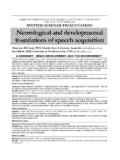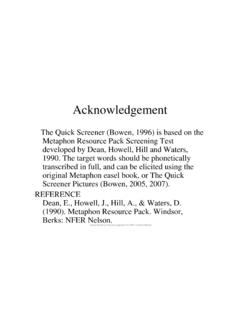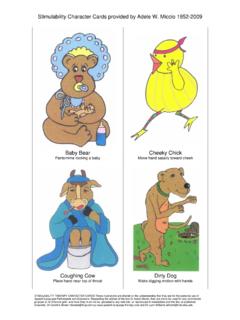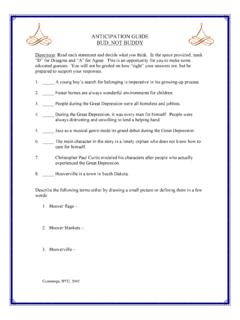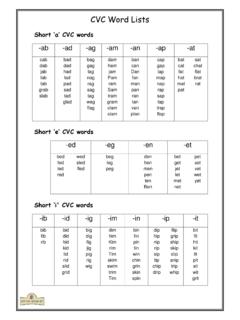Transcription of LISTENING LISTS FOR AUDITORY BOMBARDMENT
1 LISTENING LISTS FOR AUDITORY BOMBARDMENT BY Peter Flipsen Jr., , CCC-SLP, S-LP(C) Notes to the Clinician About the " LISTENING LISTS " The LISTS you find here were designed for use in focused AUDITORY stimulation (what Barbara Hodson used to call ' AUDITORY BOMBARDMENT '). You may also find them useful for other applications. This particular set of LISTS were designed based on the assumption that the child needs some help focussing on the target phoneme or phoneme combination. To that end I've tried to ensure that the target is only placed next to vowels. As well, I've tried to ensure that the vowel context changes from one word to the next. In my discussions with Dr Hodson, she agrees that the idea is for the child to pick out the target as the common element from the word list (internally; we don't actually ask them to do this).
2 By varying the context, the only common element should be the target. If you happen to spot any errors in the LISTS , please let me know. Two possible formats for focussed AUDITORY stimulation have been proposed Hodson and Paden originally thought of the process as simply reading a list of words containing the target. More recently they have suggested an alternative form where the clinician contrasts each word with the child's own error pattern ( , cup - tup - cup) so they can hear the difference. I personally favor the latter approach. Several points should be kept in mind about the LISTS : 1. For each phoneme or phoneme combination, there are 4 LISTS of 10 words each. There is no magic number as to how many words you should read. I usually find that I can read the entire set of 40 words in 1-2 minutes even using the contrast format. You needn't do all of them each time.
3 You could do half and the beginning of the session and half at the end (Hodson and Paden suggest always doing it at both ends of a session). 2. In some sets there are words that are repeated (because there are simply not enough different words available). This is not a problem since I tried to make sure that the repetitions are spread as far from each other as possible. 3. Some of the words may not be typical vocabulary for young children. This is also not a problem. The child's task is only to listen to the words - no need for them to say anything. The objective is for them to 'extract the regularities' and they can probably do this without actually knowing what some of the words mean. 4. Hodson and Paden advise against targetting certain phonemes, each for specific reasons. I have not included any of these in the LISTS . - final /l/: there is a tendency to overarticulate this one and the net result is a distorted production.
4 Working on /l/ in initial and medial position should be sufficient and in most cases should generalize to final position. - final voiced obstruents (stops, fricatives, affricates): adults quite often devoice many sounds in word final position. Working on voiced obstruents in final position may result in some confusion for the child. - interdental fricatives /;,'/: these are among the weakest sounds in the language and among the last to be learned. Working on these should likely be an absolute last thing (if they are done at all). - velar nasal /a/: many adults sustitute /n/ for this, especially in final position. As with the final voiced obstruents, working on this could lead to some confusion. 5. I've avoided the traditional labels "initial", "medial" and "final" so as not to confuse parents. I often give parents copies of the LISTS to read at home.
5 Check out the Note to Parents below. 6. I have retained the use of IPA symbols because of their exactness. I make use of a font known as PEPPERFONT which was designed by my mentor, Dr. Lawrence Shriberg for use in his lab at the Waisman Center at the University of Wisconsin-Madison. It is available to download free from Dr. Shriberg's Phonology Project website. IMPORTANT: Feel free to make use of any of these files; simply highlight those parts you wish to use with your mouse and copy and paste them into your word processing program. Peter Flipsen Jr., PhD, CCC-SLP, S-LP(C) A Note to Parents About LISTENING LISTS As part of the speech therapy program for your child, a set of LISTENING LISTS is being sent home. These are intended for you to read to your child to help increase their awareness of the sound or sound pattern being worked on in therapy.
6 As the focus of therapy changes, new LISTS will be sent home. Typically a new list will go home each week. The following points should be kept in mind: 1. Try to read the words to your child once a day (week nights especially). If your child asks to do it more often, feel free to do so. 2. Try to pick a time when you and your child can be alone and in a quiet place. Many parents find that a good time is just before the child goes to sleep. 3. Make sure your child understands that they are only to listen. Ask them to sit quietly. They should NOT be asked to repeat the words. Discourage them from repeating especially if they are not saying the words correctly. We want to avoid having them practice saying the sound the wrong way. 4. DON'T OVER-EMPHASIZE THE WORDS. Just speak clearly and at a relaxed pace (as if you were reading a story to them).
7 5. Each set will include four LISTS of words. Read at least two of the LISTS each time you have your " LISTENING time". 6. When a new list is sent, discard the old one. Only read the word LISTS for that week. Your assistance is greatly appreciated. If you have any questions, feel free to contact your Speech-Language Pathologist. LISTENING LISTS FOR AUDITORY BOMBARDMENT Words beginning with /b/ 1. beep 1. bait 1. bend 1. bid 2. bale 2. bald 2. bill 2. bell 3. bob 3. beef 3. belt 3. bath 4. beet 4. bud 4. bank 4. bay 5. ball 5. bang 5. bet 5. be 6.
8 Band 6. beg 6. bean 6. bear 7. bell 7. ban 7. bed 7. boot 8. boot 8. bus 8. bulb 8. beak 9. buy 9. bowl 9. bird 9. bug 10. bone 10. buck 10. but 10. bow Words with /b/ in the middle 1. sober 1. fiber 1. robot 1. tabby 2. robin 2. tubing 2. chubby 2. rebel 3. debug 3. rebuild 3. obey 3. hubby 4. cubic 4. habit 4. ruby 4. cabin 5. hobby 5. rubber 5.
9 Keyboard 5. lobby 6. ribbon 6. baby 6. baboon 6. soybean 7. above 7. tea bag 7. mobile 7. shabby 8. grabbing 8. cowboy 8. rabbit 8. oboe 9. aboard 9. rebound 9. labor 9. maybe 10. rubbing 10. clobber 10. caboose 10. reborn Words beginning with /p/ 1. pan 1. point 1. par 1. paw 2. pale 2. puck 2. paid 2. push 3. pop 3. pit 3. poor 3. pine 4. post 4. pour 4. pail 4. pack 5. peel 5.
10 Peck 5. peg 5. pull 6. pink 6. port 6. past 6. pump 7. page 7. pin 7. pool 7. peck 8. punt 8. pile 8. peach 8. paved 9. peek 9. pair 9. page 9. pier 10. pay 10. path 10. pep 10. pound Words with /p/ in the middle 1. copy 1. deeper 1. coupon 1. trapper 2. wiper 2. hippo 2. nippy 2. chippy 3. topping 3. sleeping 3. copper 3. report 4. suppose 4. paper 4. muppet 4.
